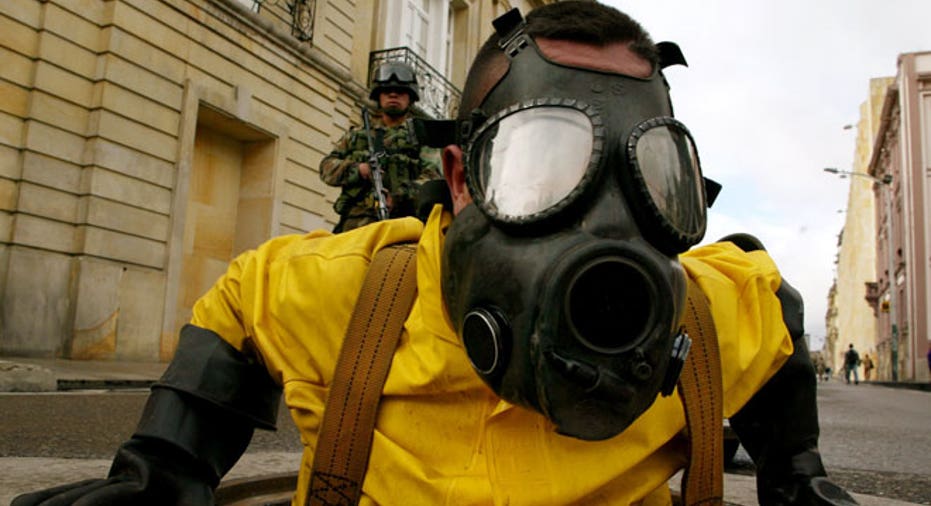Using Sewers to Sniff Out Bombs

From dogs to drones, humanity has found some really intelligent ways to sniff out bombs before they explode. But what if there were a way to catch illicit explosives even earlier?
New sensors being developed and tested by scientists sponsored by the European Union may one day help authorities track down home-made bombs (even drug factories) at their point of inception.
The sewer-based sensing system would use electrochemical water- and air-sampling to detect certain chemicals typically used for home-made bombs as they travel through the waste stream in urban areas.
Data about the time, positioning, type and concentration of compounds would be sent via sensors to a remote computer in real-time where the intelligence would be analyzed and authorities alerted to a potential threat, helping to cut off the terrorist supply chain.
“Home-made explosives can be produced from commercially everyday household chemicals,” said Hans Onnerud, deputy research director of the Department of Defense and Security, Systems and Technology at the Swedish Defense Research Agency.
“It can take time to produce bombs and we need to take advantage of that by trying to find the illicit manufacturing facilities at an early stage,” he said.
The initiative, dubbed Emphasis, is part of a European Union research program designed to find innovative ways to thwart terrorism. Created in 2006, its creation followed a series of tragedies, including the Madrid and London train bombings in 2004 and 2006, respectively, and the foiled trans-Atlantic aircraft plot in 2006.
Emphasis follows a similar project in the EU, known as Lotus, which proposed putting explosive detectors on both fixed and mobile points throughout an urban area to constantly sample air. Similarly, they envisioned its readings triggering an alarm at a central location, alerting authorities as to “chemical hotspots.”
“The idea with both of these projects is to detect starting chemicals (precursors) or explosives that can be spread to the environment when terrorist cook up bombs,” Onnerud said.
While it may be undetectable to a human, the sensors would be able to detect traces of a chemical in the air as it seeps through windows and ventilation systems, or as it travels through sewage pipe after the equipment is rinsed.
The effort right now is purely research-based, with the teams plagued with developing “research prototypes” not off-the-shelf products. However, the hope is to try to stimulate companies and industries to produce new types of detection products and systems.
“In the long run, a commercially available system of these types that has a capacity to be used for tracking bomb factories would offer a huge advantage to police authorities,” Onnerud said.
The Emphasis system will have a final demonstration at a test site in Sweden next September.
Innovative Bomb Sniffers
While Emphasis and Lotus are more focused on finding bombs in development, other technologies developed over the last decade have helped authorities track down mature bombs in busy places.
Earlier this year, University of Michigan electrical engineering professor Kamal Sarabandi, who has in the past received funding by the U.S. Department of Defense to tweak a type of radar used to find weapons and bombs concealed on a person’s body, realized his millimeter-wave radar system could also be used to flag weapons on people in busy U.S. hubs like schools, airports, malls and stadiums.
He envisions the Doppler radar-based system being able to work up to a football field away, reading people in less than a second and discovering whether they have hidden on their bodies anything from guns to suicide bomb vests.
Meanwhile, scientists with Cornell University recently created a fluorescent polymer that would offer a steady glow as normal air particles fly through it but would lose its light when it detects the presence of RDX, a difficult-to-detect principal component of plastic explosives.
And yet another highly intelligent development comes from scientists over at the Pacific Northwest National Laboratory, who have created an advanced vapor detection system that can find bomb components by measuring their molecular weights.
“This detection is several orders of magnitude better than current capabilities,” the PNNL researchers David Atkinson and Robert Ewing say in the report.
While vapor detection is challenging due to the low vapor pressure of many compounds -- canines are the primary method for this method of detection currently -- the researchers say their advancement can detect 10 parts per quadrillion, equivalent to 10 tiny kernels among all of the wheat harvested in the U.S. last year.
Their hope is that it eliminates costly consumables such as sample swipes, offering a less expensive and more effective and reliable means of “quickly and easily” screening people for chemical signatures.
“The small and efficient system envisioned could be paired with existing airport security screening processes that neither extends the process nor adds to any traveler inconvenience,” PNNL researchers wrote in a note.
These emerging technologies have already helped authorities immensely in detecting bombs before they explode. However, as evidenced with the Boston Marathon bombing earlier this year, the home-made Oslo bomb in 2011 and the Times Square car bombing attempt in 2010, the threat is omnipresent.
Protecting citizens from homemade and mature explosives and terrorist attacks has become a priority for governments around the world, and advanced bomb-sniffing developments give them the ability to be more vigilant.
"Terrorism and IEDs are never going away so we need to be able to screen people more effectively," Atkinson said.